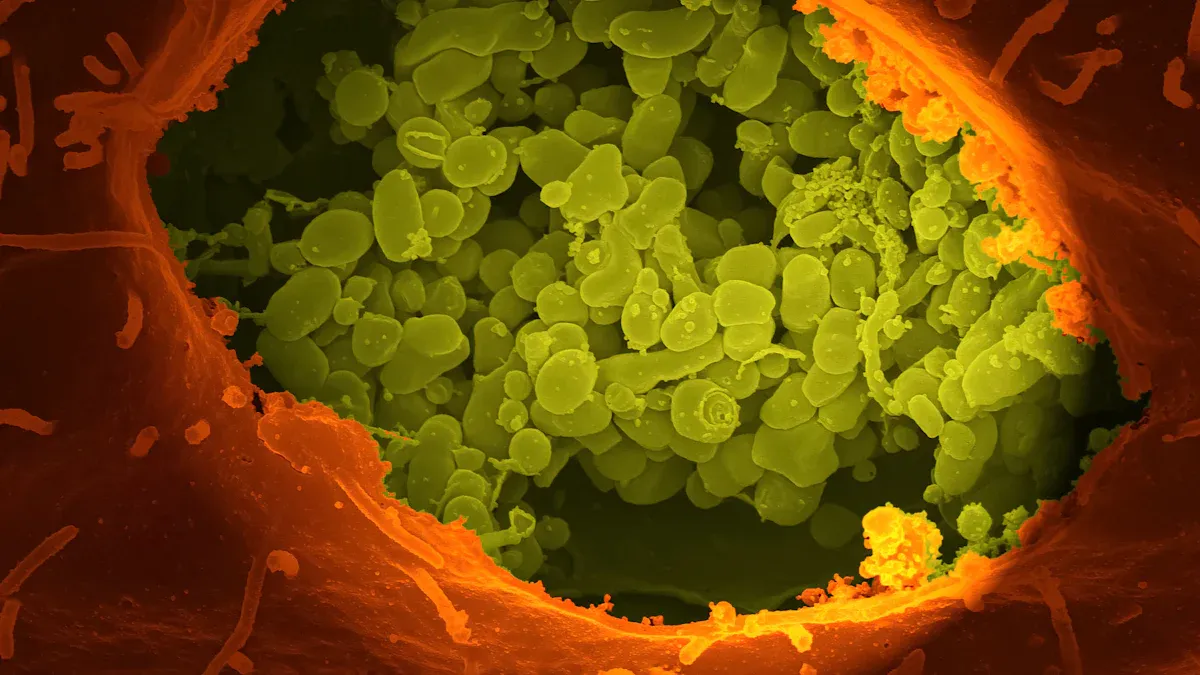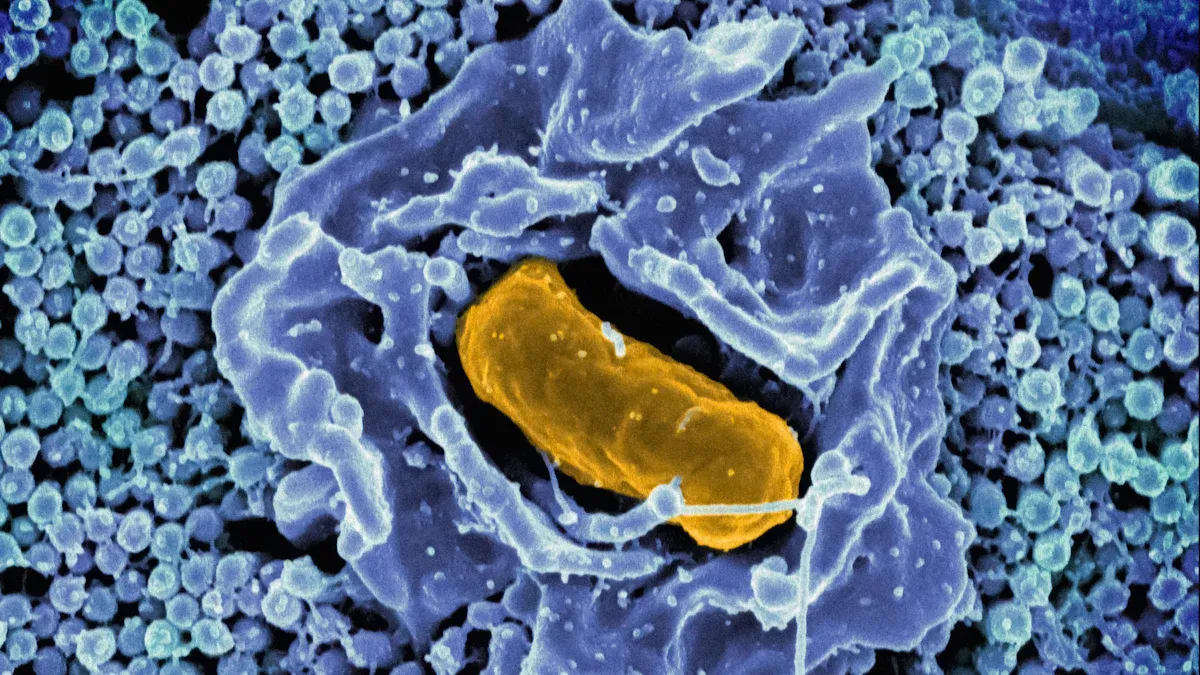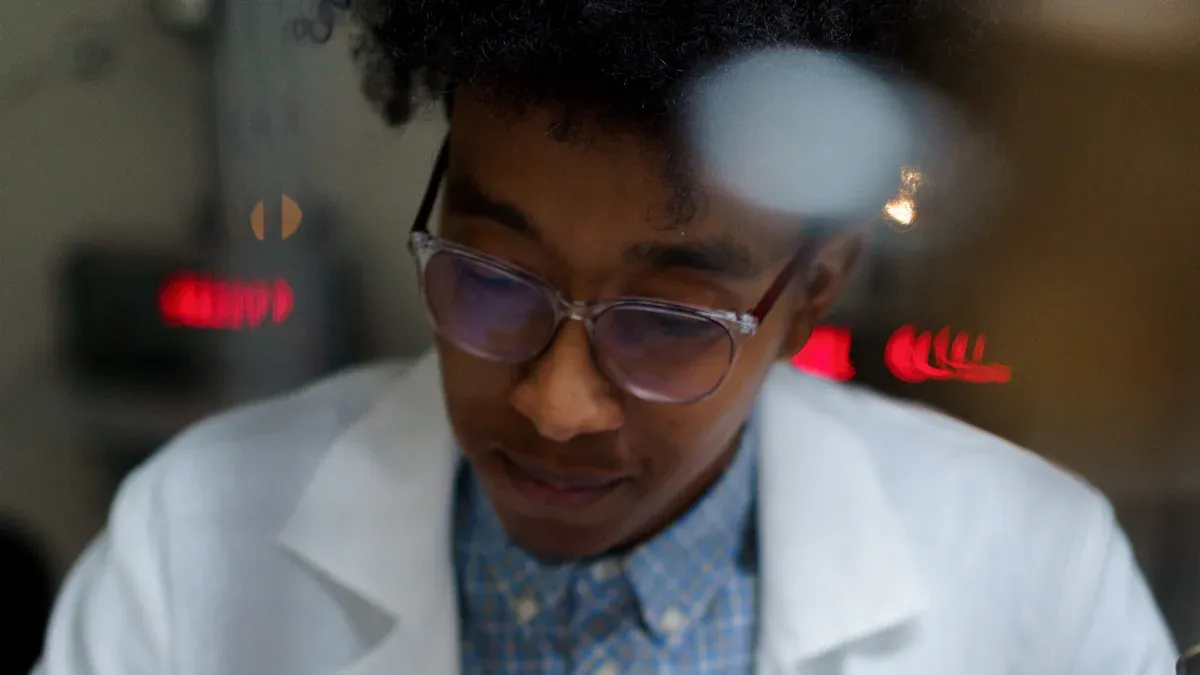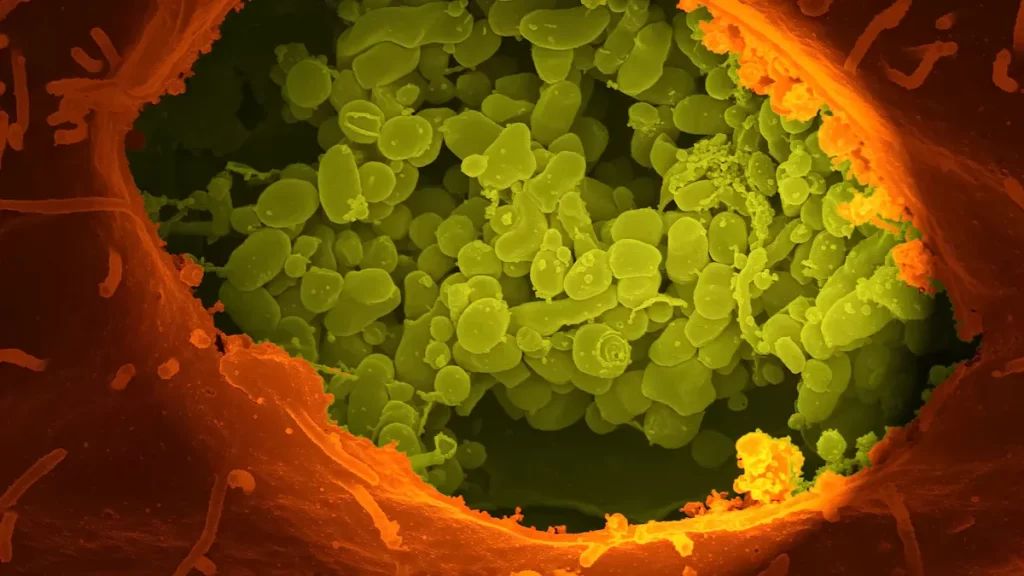News & Events
Troubleshooting Electric Shocking Plasmids into Cells for Better Transformation Outcomes

You want to see better results in your lab when you use the electric shocking plasmids into cells technique. This method can change your molecular cloning and sequencing outcomes. By adjusting the electric shocking plasmids into cells technique, you can boost transformation efficiency. For example, setting the voltage to 1.8 kV instead of 2.0 kV can give you up to 20 times more colonies. After you use the electric shocking plasmids into cells technique, letting cells recover for 12 hours instead of 4 hours can triple your results. When you troubleshoot the electric shocking plasmids into cells technique, you set yourself up for success every time.
Key Takeaways
- Adjust the voltage during electroporation. Using 1.8 kV instead of 2.0 kV can increase colony counts significantly.
- Let cells recover for at least 12 hours after electroporation. This recovery time can triple your transformation results.
- Always mix plasmids with competent cells before applying the electric pulse. This step is crucial for successful DNA uptake.
- Use fresh, healthy competent cells and the right buffer for your specific e. coli strain. Proper preparation boosts transformation efficiency.
- Follow a checklist for each transformation step. This practice helps ensure consistency and improves your overall results.
Electric Shocking Plasmids into Cells Technique

Electroporation Basics
Electroporation gives you a powerful way to introduce plasmids into competent cells. You use an electroporator to send a short electric pulse through a suspension of competent cells and plasmids. This pulse creates temporary pores in the cell membrane. DNA, including plasmids, must be present during the pulse. If you add plasmids after the pulse, the pores close before DNA can enter. You need larger pores for plasmids to move into the cell. The electroporation method works well for both small and large plasmids. You can use it with wild-type strains that are hard to transform with other methods.
Tip: Always mix plasmids with competent cells before you apply the electric pulse. This step helps you get better transformation results.
Recent advances in electroporation equipment help you achieve higher transformation efficiency. New devices optimize pulse schedules and reduce cell damage. You can process more samples at once, which improves your transformation outcomes.
Key Steps in Transformation
You need to follow several steps for successful transformation:
- Prepare competent cells. You can use electrocompetent cells or chemically competent cells.
- Mix plasmids with competent cells.
- Transfer the mixture to a chilled cuvette.
- Apply the electric pulse using the electroporator.
- Add recovery medium right after pulsing.
- Incubate the cells to allow them to express the plasmid.
- Plate the cells on selective media.
Electrocompetent cells usually give you higher transformation efficiency than chemically competent cells. Chemically competent cells use calcium chloride to help plasmids attach to the membrane. Electrocompetent cells respond better to the electric pulse, so you see more colonies after transformation.
Common Pitfalls
You may face some problems during transformation:
- If you use old or poorly prepared competent cells, you get low transformation efficiency.
- If you forget to add plasmids before the pulse, DNA cannot enter the cells.
- If the cuvette is wet, you may see arcing, which kills the cells.
- If you use the wrong voltage, you may damage the cells or get few colonies.
Note: Always check your competent cells and plasmids before starting transformation. Use fresh reagents and follow the protocol closely.
Transformation Efficiency Factors
Cell Preparation
You need to start with healthy competent cells to get the best transformation results. The way you prepare these cells can change your transformation efficiency. For e. coli, you should grow the bacteria to a specific stage before collecting them. Place the cells in an ice bath for 15 minutes to help with preparation. The buffer you use for electroporation also matters. Different strains of e. coli may need different buffers. Some buffers work better for certain cells, so always check which one fits your experiment.
Temperature shifts during preparation can make a big difference. If you use room temperature competent cells, you can see a 10-fold increase in transformation efficiency compared to cold cells. Letting cold cells warm up to room temperature for 15 minutes can give you a 5-fold boost. If you put room temperature cells back on ice, you may see a big drop in transformation efficiency. For e. coli and other Gram-negative bacteria, preparing competent cells at room temperature often works better than the old method of keeping everything cold.
Here is a table showing some critical factors during cell preparation:
| Factor | Description |
|---|---|
| Presence of antibiotics | Antibiotics help select for transformed cells, improving transformation efficiency. |
| Plasmid origin of replication | High copy number origins usually give better transformation rates in e. coli. |
| Transformation conditions | Preparation steps, heat shock, growth medium, and contaminants all affect transformation. |
| Damage to DNA | UV light can harm DNA. Buffers with cytidine or guanosine can protect DNA during transformation. |
Tip: Always use fresh, healthy competent cells and the right buffer for your e. coli strain. Avoid temperature swings that can lower your transformation efficiency.
Plasmid Quality
Plasmid quality plays a big role in transformation. If you use large plasmids, you may see lower transformation efficiency. High concentrations of plasmid DNA can also hurt the survival of e. coli cells. You want to use clean, pure plasmid DNA at the right concentration. Too much DNA can stress the cells and lower your transformation efficiency. The calcium chloride method can help you prepare competent cells, but you still need to check your plasmid quality before starting.
Note: Always check your plasmid size and concentration. Use only what you need for your transformation.
Electroporation Settings
The settings you choose for electroporation can change your transformation results. Voltage and pulse duration affect how many pores form in the cell membrane. Higher voltage and shorter pulses make more small pores, which can help DNA enter e. coli cells. You can also use different pulse shapes, like exponentially-decaying or trapezoidal pulses, to target different parts of the cell.
Here is a table with some starting electroporation settings for different cell types:
| Cell Line | Nucleic Acid | Starting Conditions |
|---|---|---|
| HUVEC | siRNA/plasmid | Sq: 250 V, 20 msec, 2000 μF, 1000 Ω |
| Jurkat | siRNA | Exp: 250 V, 300 μF, 1000 Ω |
| Neuro-2a | siRNA | Exp: 250 V, 350 μF, 1000 Ω |
| SK-N-SH | siRNA/plasmid | Sq: 200 V, 20 msec, 2000 μF, 1000 Ω |
| A549 | Sq: 300 V, 2000 μF, 1000 Ω, 20 msec | |
| CHO K-1 | siRNA | Sq: 250 V, 2000 μF, 1000 Ω, 20 msec |
| MCF-7 | siRNA | Exp: 250–300 V, 250 μF, 1000 Ω |
| HeLa | siRNA | Exp: 250 V, 350 μF OR Sq: 250 V, 20 msec |
| COS-7 | plasmid | Sq: 220 V, 2000 μF, 1000 Ω, 20 msec |
| K562 | plasmid | Exp: 300 V, 250 μF, 1000 Ω |
For e. coli, you often use 1.8–2.5 kV for a 0.1 cm cuvette. Always check your electroporator manual for the best settings. The calcium chloride method does not use electric pulses, but you can compare results to see which method gives you higher transformation efficiency.
Recovery Conditions
After electroporation, you need to help your e. coli cells recover. The recovery buffer and incubation temperature both affect transformation efficiency. Buffers with the right conductivity and magnesium ions (Mg2+) can improve cell survival and transformation. If you keep cells cold after electroporation, you may hurt their recovery. Warm incubation helps the cells repair and express the plasmid.
- Use a recovery buffer with Mg2+ to boost transformation efficiency.
- Avoid keeping cells at cold temperatures after electroporation.
- Incubate at 30–37°C for best results with e. coli.
- Let cells recover for at least one hour before plating.
Tip: Always use fresh recovery buffer and keep your incubation temperature steady. This step helps you get more colonies after transformation.
Practical Tips for High Efficiency Transformation
You can follow these steps to get high transformation efficiency with e. coli:
- Sterilize all solutions and tools before starting.
- Prepare at least four plates for each transformation.
- Grow a single e. coli colony in rich medium until it reaches the right density.
- Collect cells by centrifugation and wash with ice-cold water, then with electroporation buffer.
- Condition the cells if needed, using the calcium chloride method or other treatments.
- Electroporate at the recommended voltage for your cuvette size.
- Recover cells in a buffer with Mg2+ at 30–37°C for at least one hour.
- Plate the cells on selective media and incubate overnight.
Remember: Each step in the transformation process can affect your final transformation efficiency. Small changes in temperature, buffer, or DNA quality can make a big difference.
Troubleshooting Transformation

Low Colony Yield
You may notice that your transformation sometimes produces very few colonies. This problem can slow down your experiments and make you question your transformation procedure. Several factors can cause low colony yield during transformation:
- You may have skipped glycerol in your SMP buffer. Glycerol helps cells survive the electric pulse. Without it, you see fewer colonies.
- If you do not let cells recover long enough after electroporation, you get poor results. Studies show that a 16-hour recovery period after electroporation can give you about 400 colonies per microgram of DNA. Shorter recovery times often lead to fewer colonies.
- The amount of plasmid DNA you use matters. Using 2 to 4 micrograms of plasmid DNA gives you the most consistent colony numbers. If you use less DNA, you may not see colonies every time.
Tip: Always check your buffer ingredients, recovery time, and DNA concentration before starting the transformation. These steps help you get the best yield.
Arcing Issues
Arcing happens when you see a spark or hear a pop during electroporation. This event can kill your cells and ruin your transformation. Arcing usually comes from high salt or impurities in your DNA sample or buffer. You can use the table below to see how salt and impurities affect arcing:
| Source | Key Findings |
|---|---|
| The Ins and Outs of Messenger RNA Electroporation for Physical Gene Delivery in Immune Cell-Based Therapy | High salt concentrations can lead to arcing, which negatively impacts cell viability and transfection efficiency. |
| The Best Way to Desalt DNA for Electroporation | Conductivity must be kept low to prevent arcing; even small amounts of ligation mixture can cause failure. |
| How To Prevent Arcing And Sample Damage In Electroporation Cells | High-conductivity buffers increase the risk of arcing due to localized conductivity. |
| Easily applicable modifications to electroporation conditions improve the transformation efficiency rates for rough morphotypes … | Salt-free DNA suspensions reduce arcing episodes during electroporation. |
If you face arcing during transformation, follow these steps:
- Check your competent cell preparation. Make sure you followed the protocol.
- Keep your cuvettes cold before use. Store them in the freezer until you need them.
- Check the concentration of DNA and cells. Dilute them if they are too concentrated.
- Remove air bubbles from the cuvette. Air bubbles can cause uncontrolled shocks.
- Adjust your electroporator settings to match your cuvette size.
- Check for impurities in glycerol or other reagents.
- If arcing continues, try electroporating without DNA. This step helps you see if the problem comes from the cells or the DNA.
Note: Always use salt-free DNA and keep your buffers clean. This practice helps prevent arcing and improves your transformation efficiency.
Poor DNA Uptake
Sometimes, your cells do not take up the plasmid DNA well during transformation. This problem leads to low transformation efficiency and fewer colonies. Several factors can cause poor DNA uptake:
- You may use sub-optimal electrical parameters. The voltage or pulse length may not be right for your cells.
- Your plasmid preparation may contain high salt. Salt blocks DNA from entering the cells.
- Large plasmids (over 10 kb) are harder for cells to take up.
- If your plasmid concentration is too low, you see poor transformation results.
- Stressed, damaged, or contaminated cells do not take up DNA well. Mycoplasma contamination can also lower transformation efficiency.
- Cell density matters. If you use too few or too many cells, you get poor results.
- Cells with a high passage number often show lower transformation efficiency.
You can improve DNA uptake by increasing plasmid concentration, but too much DNA can lower cell survival. You need to find the right balance for your transformation procedure.
| Parameter | Effect on Efficiency |
|---|---|
| T cell activation | Higher efficiency observed after 3 days of activation |
| Applied voltage | Optimal at 500V; higher voltages decrease viability |
| Initial cell number | Higher numbers generally increase transfection efficiency |
| Plasmid concentration | Increased plasmid input leads to higher efficiency but may reduce viability |
Tip: Always use fresh, healthy cells and clean, salt-free DNA. Adjust your voltage and cell density for each transformation to get the best results.
Recovery Failures
After electroporation, your cells need time to recover. If recovery fails, you see few or no colonies after transformation. Recovery involves two main steps:
- Partial recovery happens quickly. The cell membrane forms temporary pores that close within minutes.
- Membrane resealing takes longer. Complex pores, called metastable pores, may take 5 to 30 minutes to close.
If you use more than one electric pulse, you can reopen these pores and sometimes improve recovery. However, too many pulses can damage the cells.
You can prevent recovery failures by:
- Giving your cells enough time to recover after electroporation.
- Using the right recovery buffer with magnesium ions.
- Keeping the incubation temperature steady at 30–37°C.
- Avoiding cold temperatures during recovery.
Remember: Good recovery is key for high transformation efficiency. Always monitor your recovery steps closely during bacterial transformation.
You can overcome many obstacles in transformation by using new devices and improved protocols. Microfluidic devices and better electrode designs now help you get higher transformation efficiency and better cell survival. These advances make your transformation procedure more reliable and scalable.
High Efficiency Transformation Checklist
Cell Prep Steps
You want to start your transformation with healthy cells. Begin by growing E. coli overnight at 37°C with shaking. Chill your glass centrifuge tube, microcentrifuge tube, electroporation cuvette, and water on ice. Cool your centrifuge chamber to 4°C. Wash E. coli several times with ice-cold water. Pour the culture into the prechilled tube on ice. Centrifuge at 7000 rpm, discard the supernatant, and resuspend the pellet in cold water. Transfer the cells to a chilled microcentrifuge tube. Spin again, discard the supernatant, and resuspend the pellet. Mix E. coli with plasmid DNA and move the mixture to a chilled electroporation cuvette. These steps help you achieve high efficiency transformation.
Tip: Always use fresh cells and keep everything cold during preparation. This practice boosts transformation results.
Electroporation Setup
Set up your electroporation carefully. Choose the right voltage and pulse length for your cell type. Lower intensity pulses help more cells survive, which increases colony numbers after transformation. Use positive control plasmids that show expected results, like green fluorescent cells. Design controls that match your experiment. Universal control samples and benchmarks help you check reproducibility. Standardized reporting formats make your transformation results consistent.
| Step | Purpose |
|---|---|
| Select voltage | Optimize cell survival and DNA entry |
| Use controls | Ensure reproducibility |
| Benchmark results | Compare transformation outcomes |
DNA and Buffer Tips
Prepare your DNA and buffers with care. Start with E. coli from a glycerol stock and streak on LB-agar plates with antibiotics. Incubate overnight at 37°C. Pick a single colony and grow it in LB medium with antibiotics. Transfer the culture to prewarmed LB medium and shake until OD600 reaches 0.5. Cool the culture on ice and centrifuge to collect cells. Resuspend in cold TFB1 buffer and keep on ice for 90 minutes. Centrifuge again and resuspend in ice-cold TFB2 buffer. Prepare aliquots and freeze for storage. Clean, salt-free DNA and fresh buffers help you reach high efficiency transformation.
Note: Always check DNA purity and buffer composition before starting transformation.
Recovery and Plating
After electroporation, add 40 μL of SOC recovery medium right away. Incubate at 37°C for one hour. This step helps cells recover and express the plasmid. Plate the cells on selective media. The intensity of electroporation affects survival and colony formation. Lower intensity gives higher survival and more colonies. You may see an average of 48 colonies per well. Results can vary, so optimize your recovery and plating methods for high efficiency transformation.
- Add recovery medium promptly.
- Incubate at the right temperature.
- Plate on selective media for accurate transformation results.
Tip: Optimize recovery and plating steps to maximize colony counts and transformation efficiency.
You can improve transformation results by following key troubleshooting steps. Each part of the transformation process matters. You need to use the right wash buffers, voltage, and recovery time. The table below shows how these factors change transformation efficiency:
| Parameter | Effect on Transformation Efficiency |
|---|---|
| Wash Buffers | Different buffers impact electroporation efficiency. |
| Voltage Settings | Optimal voltage found to be 1.8 kV for higher CFUs. |
| Post-Electroporation Recovery | 12 h recovery time yields 3-fold higher CFUs than 4 h. |
You should use the transformation checklist for every experiment. Studies show that following a checklist helps you reach better transformation outcomes. The checklist gives you a clear path for each transformation step. You can adjust your transformation protocol and see what works best. Every time you use the checklist, you make your transformation more reliable. Try new settings and record your transformation results. You will see more colonies and better transformation efficiency. Keep testing and improving your transformation process. Your careful work will lead to successful transformation in your lab.
FAQ
What is the main advantage of electroporation over chemical transformation?
You can use electroporation to introduce large plasmids into cells more easily. This method works well for many cell types. You often see higher transformation efficiency compared to chemical methods.
How do you prevent arcing during electroporation?
You should use salt-free DNA and clean buffers. Always chill your cuvettes and remove air bubbles before pulsing. These steps help you avoid arcing and protect your cells.
Why does recovery time matter after electroporation?
Cells need time to repair their membranes and express new genes. If you let cells recover for at least one hour, you see more colonies. Longer recovery can improve your transformation results.
Can you use this technique for genetic studies in other organisms?
Yes, you can use electroporation for genetic research in bacteria, yeast, and even mammalian cells. Always adjust the settings for each organism to get the best results.
What should you do if you get no colonies after transformation?
Check your competent cells, DNA quality, and electroporation settings. Make sure you use the right recovery medium and temperature. Try a positive control to see if your protocol works.

